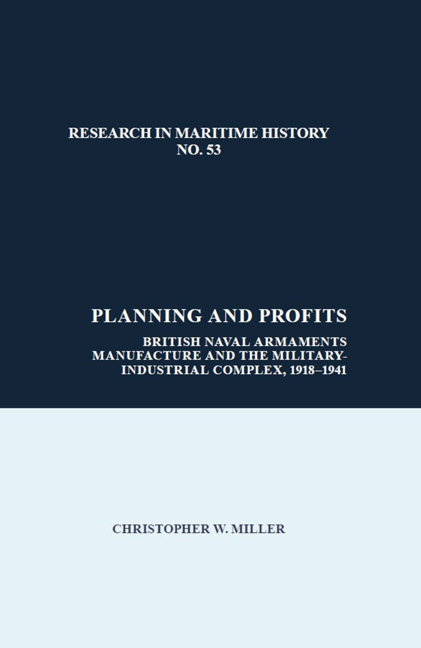 Planning and Profits
Planning and Profits Book contents
- Frontmatter
- Contents
- Acknowledgements
- About the Author
- List of Tables and Figures
- List of Illustrations
- List of Abbreviations
- A Note on Definitions
- Part One Introduction
- Part Two Industry and the Navy before Manchuria, and the Establishment of the Warshipbuilders’ Committee, 1919–1931
- Part Three The Formation of a National Government, the Far East, and the PSOC Approach to Industry, 1931–1934
- 5 From “Outsiders” to “Insiders”: Industry and the Rehabilitation of the Supply Planning Framework
- 6 The Advisory Panel of Industrialists and Inside Information, 1933–1934
- Part Four The Ultimate Potential Enemy and Rearmament Planning, 1934–1936
- Part Five The Inskip Era and War, 1936–1941
- Conclusion and Retrospective
- Appendices
- Bibliography
- Index
5 - From “Outsiders” to “Insiders”: Industry and the Rehabilitation of the Supply Planning Framework
from Part Three - The Formation of a National Government, the Far East, and the PSOC Approach to Industry, 1931–1934
- Frontmatter
- Contents
- Acknowledgements
- About the Author
- List of Tables and Figures
- List of Illustrations
- List of Abbreviations
- A Note on Definitions
- Part One Introduction
- Part Two Industry and the Navy before Manchuria, and the Establishment of the Warshipbuilders’ Committee, 1919–1931
- Part Three The Formation of a National Government, the Far East, and the PSOC Approach to Industry, 1931–1934
- 5 From “Outsiders” to “Insiders”: Industry and the Rehabilitation of the Supply Planning Framework
- 6 The Advisory Panel of Industrialists and Inside Information, 1933–1934
- Part Four The Ultimate Potential Enemy and Rearmament Planning, 1934–1936
- Part Five The Inskip Era and War, 1936–1941
- Conclusion and Retrospective
- Appendices
- Bibliography
- Index
Summary
The three politically tumultuous years that followed the formation of the National Government in 1931 fundamentally transformed the nature of defence planning and the relationship between government and industry. Between 1922 and 1931, the debate between Admiralty and Treasury had been comprehensively won by the latter's view on spending limitations. The Committee of Imperial Defence (CID) and its subcommittees had not been called upon to work on pressing matters of national security, but spurred by the changes in the political situation after the Japanese invasion of Manchuria, it adopted a far more central planning role and contributed a great deal towards understanding British defensive deficiencies by 1934. Thus, it was the CID, comprised of all three fighting services, and not just the Admiralty, which became the vehicle for articulating Britain's defence needs to the Cabinet.
This resulted in industrialists playing a key role in advising, and then shaping, defence policy for the first time. On the other hand, by 1934 the Admiralty also began competing more intensely with the developing Air Force for a share of the defence budget. Thus, while the narrative to this point has stressed the private industry's existence outside of the state planning framework and consequently has focussed on industry's responses to the crises in the 1920s and the Admiralty-Treasury disputes, from 1931 onwards the increasing importance of the CID warrants a more detailed examination of the process that gave new meaning to defence planning and that subsequently led to approaching industrialists for assistance.
Overview: Constraints and Pressures
Between Washington and Manchuria, support for the navy had been occasionally vocal but rarely consistent. Winston Churchill argued in favour of increased naval expenditure almost as often as he argued against it before and between 1918 and 1931, first supporting expansion of the fleet before slashing naval estimates and finally implementing the Ten Year Rule for perpetuity. This sort of behaviour was not unique to him: past, present and future Prime Ministers Stanley Baldwin, David Lloyd George and Ramsay MacDonald had periods on both sides of the divide, at times supporting the centrality of the navy to British defence, at others angrily being described by Admiralty figures as “dangerously imperilling everything for which the Royal Navy stands.”
- Type
- Chapter
- Information
- Planning and ProfitsBritish Naval Armaments Manufacture and the Military-Industrial Complex, 1918–1941, pp. 79 - 102Publisher: Liverpool University PressPrint publication year: 2018


